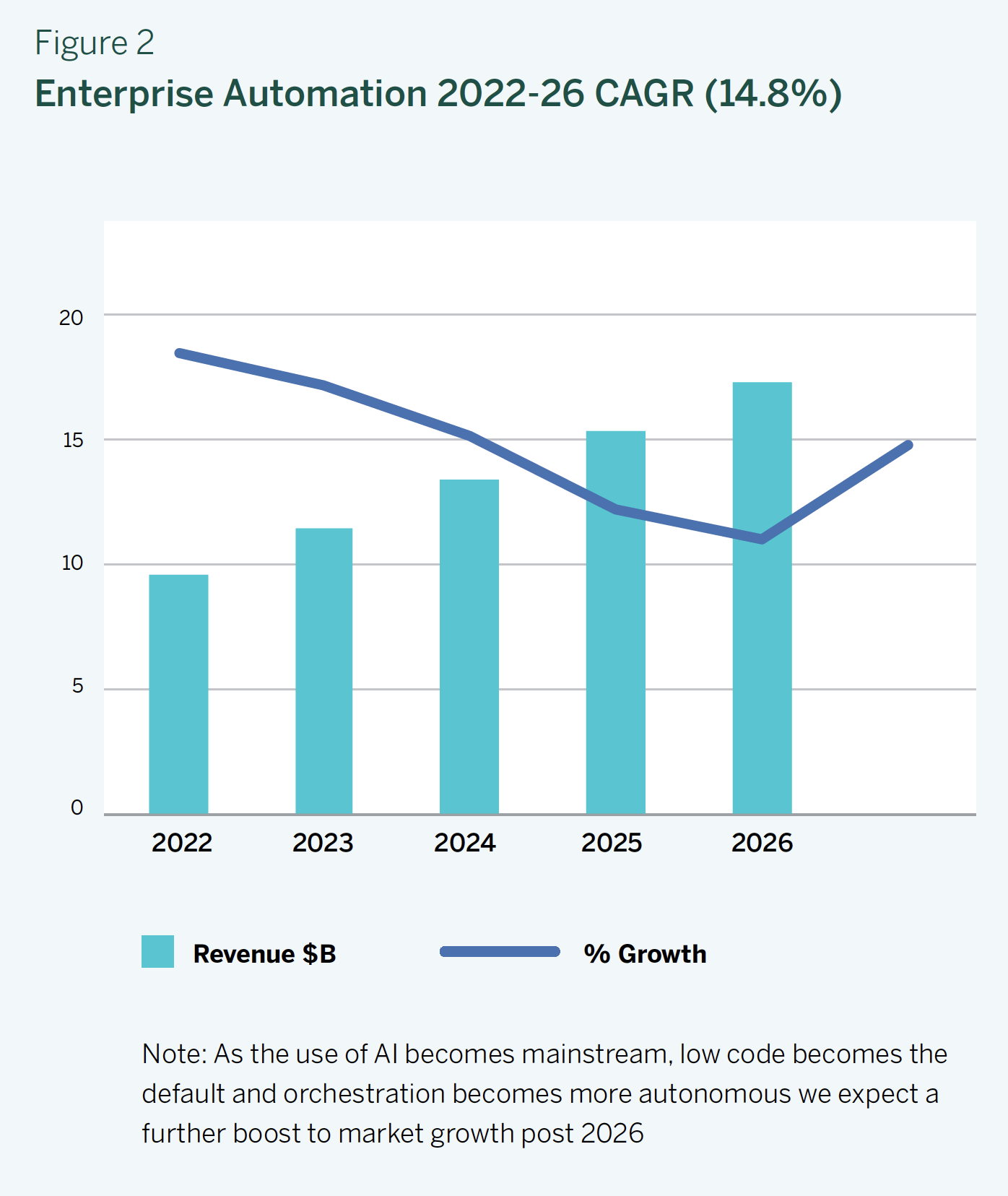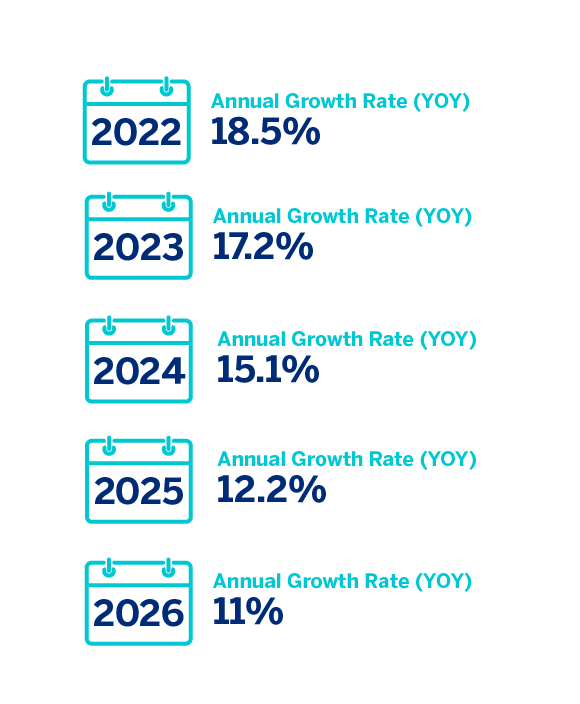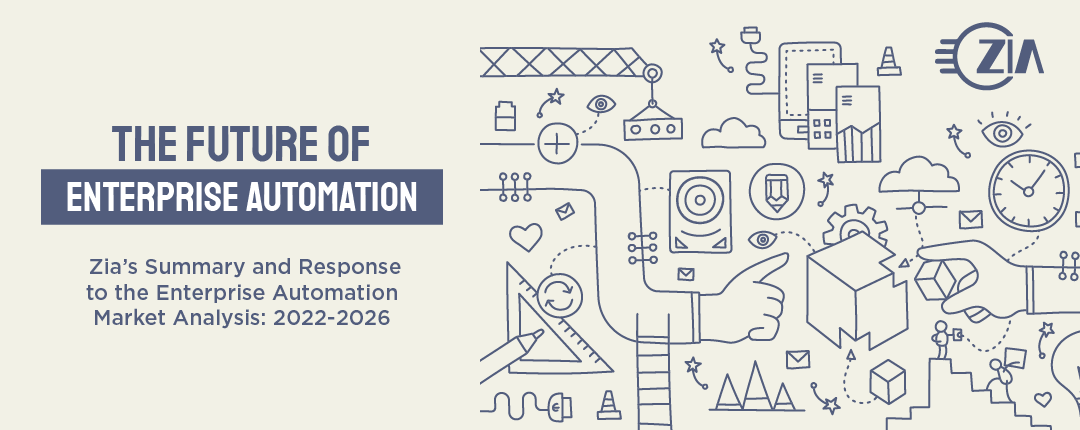This is a summary of the recent report addressing how the enterprise automation market is defined by looking at size and forecast, growth, and factors that drive buying decisions. While the ability to orchestrate and optimize the numerous, complex tasks that run against a myriad of business processes is beyond this report, it is critical to the success of enterprise automation. Zia Consulting understands this and can help you optimize and orchestrate functionality instead of using disconnected EA systems.
Today’s companies are challenged to fill unwanted positions, improve customer and employee satisfaction, and stop using qualified people to do highly repetitive, inefficient and costly manual tasks. This is why Zia Consulting is highly focused on enterprise automation by utilizing their expertise in converting unstructured content into structured data that enables full automation of core back end processes. These priorities are backed by The 2022 AIIM Industry Watch, as well as AIIM’s Enhancing Your RPA Implementation with Intelligent Information Report that shows 70% of organizations say that unstructured content in the form of documents, emails, or text is the Achilles Heel of RPA implementations.
The Enterprise Automation Market
Defining the Market
While there are several different and ever-changing marketing labels to describe EA, this analysis focused on the most common technologies, including business process management (BPM), robotic process automation (RPA), low code, aka low-code application development (LCAP), and rules and decision engines. One notable shift in the market is that instead of shortlisting similar vendors to solve business problems, companies are increasingly shortlisting divergent solutions and vendors to find different solutions.
Size, Growth, and Forecast
- RPA functionality will be commoditized and provided at low cost, or even free. Pure RPA plays will be more difficult.
- BPM will be impacted by fast growth and low-code options, especially for simple, straightforward, process-centric applications.
- Automated intelligence (AI) and machine learning (ML) will grow, but make less of an impact on the market than originally thought.
- Cost and business challenges will be impacted by gloomy global economy.

Promises Versus Reality
Automation projects start with a thorough business analysis, and the use of modern-day task and process mining software make for quicker and more accurate insights into the business. In addition, the hundreds of EA vendors that have entered the market contribute to huge technical advances and newer automation systems that are faster and easier to deploy. Though this is promising, the reality is that automating business processes effectively continues to be difficult and requires deep expertise and accompanying skills. Projects fall short when companies don’t have skilled employees or the money needed to analyze the business and embark on a EA project. In addition to the lack of expertise, unstructured and semi-structured content are blockers. In short, the full potential of a growing market is limited by lack of expertise.
Zia’s Consulting has deep expertise in making unstructured content, structured. By doing this, content is useful to RPA and the promise of end-to-end automation is realized. The core of Zia’s methodology is working with the customer to create a three year roadmap and then ensuring that customers move successfully through the pilot, project, and program stages in 90 day increments. Their proven methodology ensures that projects don’t fail.
Competition and Demand
Enterprise automation is very competitive and almost all enterprise software vendors use low-code approaches. Beyond the IBM’s of the world, hundreds of small vendors and startups are entering the market. This is indicative of a rapidly growing and changing marketplace. The smaller RPA sector is dominated by just a few vendors, including one of Zia’s partners, UiPath. Salesforce, Microsoft, and Oracle are among those dominating the LCAP market for enterprise automation.

Market Developments between 2022-2026
In 2022, RPA vendors realized that they could no longer overpromise solutions. Customers want to show the ROI of RPA and the benefits of buying large numbers of bots. While RPA found a place in the broader enterprise automation market as a supporting technology for more complex business-critical process improvement work, a recent AIIM report showed that most organizations surveyed stopped at 50 bots because they couldn’t see the full potential of end-to-end automation. There was also some significant M&A activity in 2022.
2023 promises rapid acceleration of the adoption of these technologies in major process automation projects. EA vendors also see the rapid growth of the intelligent document processing (IDP) market, and accessibility and low cost of AI & ML-driven document processing technologies. The combination of multiple startups in the AI/NLP space and challenging economic environment will likely lead to more acquisitions by EA vendors.
Enterprise automation optimization and orchestration is expected to take center stage in buying decisions in 2024. The past five years showed the deployment of hundreds of RPA bots alongside broader and deeper process automation and low-code developed applications. While this is expected to continue, most of it was uncoordinated, with most deployments only loosely connected or organized. This means that the need to bring order to growing chaos is going to drive interest and spending on broader tool sets that optimize and orchestrate these systems and activities.
In 2025, expect a rise in newer approaches that eliminate and automate traditional processes. This is driven by the use of blockchain and AI/ML. Though there are excellent AI/ML modules and blockchain systems available in 2022, few buyers or vendors know how to deploy or use them beyond the proof-of-concept stage. The gap is likely to close as consultants and systems integrators will learn to target redundant data and document activities with blockchains, and AI/ML will enable more effective automation of highly complex decision-centric process activities.
In 2026 we will see AIOps becoming a key element in the enterprise automation stack. We will also
start to see system monitoring take a deeper interest in complex process environments. Some pure-play RPA vendors may still exist. However, expect RPA with task and process mining to be included as functionality within broader suites.
Zia Consulting strives to stay ahead of the curve by understanding what the future holds. Zia is highly focused on enterprise automation and can utilize their deep expertise in converting unstructured content into structured data to make automation a reality for your company. Stop wasting time and money filling unwanted positions or allowing highly qualified people to do tasks that can be automated. Take the actions necessary to ensure customer and employee satisfaction. Zia has decades of experience helping customers do these exact things. Contact us today to learn more about how they can support your specific enterprise automation needs.

ABOUT THE AUTHOR
Shelly Mahon, VP of Marketing
After a long career of researching, teaching, writing, editing, speaking, developing and marketing parent education programs and products, and serving as the executive director of a non-profit, Shelly has landed as the VP of Marketing for Zia Consulting. She works with the company’s marketing, sales and executive teams to implement a strategic marketing plan focused on lead generation, brand awareness, and client and partner support. She also conducts market research, and assists the sales team in supporting existing clients and moving prospective clients through the sales funnel. She is passionate about building relationships and working in a way that is focused on being efficient, effective, and thoughtful. When not at work, she is an avid cyclist, mountain-biker, skier, runner, and parent educator.

